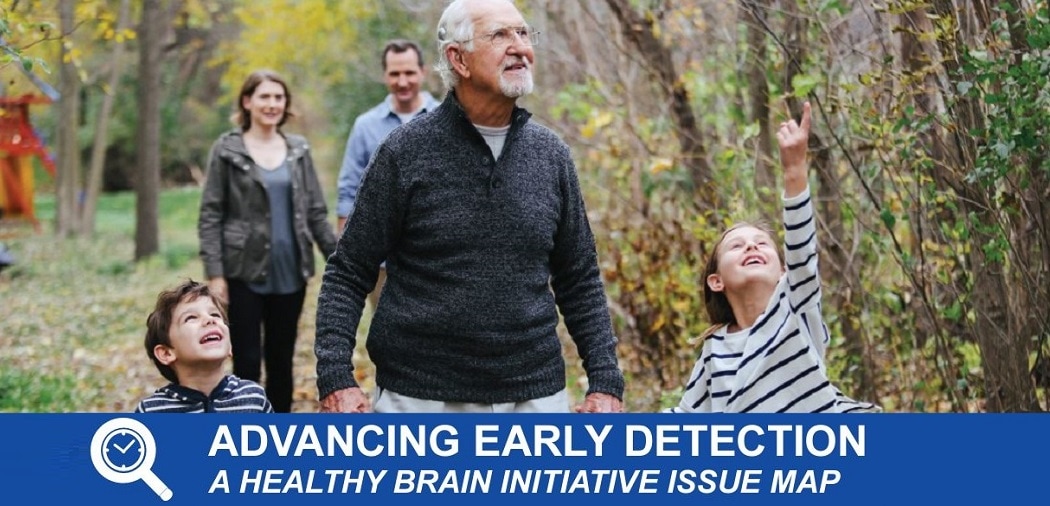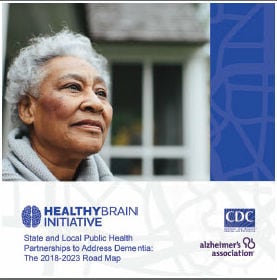Advancing Early Detection

Available for download [PDF – 3 MB]
ADVANCING EARLY DETECTION to Make Alzheimer’s Our Next Public Health Success Story
The earlier that Alzheimer’s and other dementias are diagnosed, the sooner people and their families can receive information, care, and support. As the compelling data indicate, many Americans are not being diagnosed early or told about their diagnosis.
The symptoms of Alzheimer’s and other dementias worsen over time, although the rate at which he disease progresses varies. In the early stage of Alzheimer’s dementia, for example, a person may function independently, still drive, work, and be part of social activities. Despite this, the person may notice memory lapses, such as forgetting familiar words or the location of everyday objects.
A formal diagnosis allows people living with dementia to have access to available symptomatic treatments and interventions, build a care team, participate in support services, and potentially enroll in clinical trials. They and their caregivers can set systems in place to better manage medications, receive counseling, and address the challenges of other chronic conditions.
Additional advantages include planning for future financial and legal needs and end of life choices.
Public health can impact early detection and diagnosis by developing professional competencies needed to effectively and compassionately interact with and assess people with cognitive impairment and their caregivers. For timely and accurate early detection to occur — and subsequent diagnosis and disclosure awareness — people must feel comfortable discussing symptoms and concerns with their healthcare providers. This requires addressing barriers such as low public awareness of the early signs of Alzheimer’s, emotional distress of Alzheimer’s and other dementias on family members, and misperceptions about Alzheimer’s and other dementias.1,2 In addition, public health should consider addressing obstacles faced by physicians such as: low recognition of the signs of cognitive impairment; confusion with conditions that may mimic dementia (including delirium, certain vitamin deficiencies, and depression); limited education or training on dementia care; concerns about stigma and the usefulness of an early diagnosis; lack of time; and difficulty
talking about dementia or disclosing a diagnosis.3,4,5,6
COMPELLING DATA
Nearly 90% of Americans say that if they were exhibiting confusion and memory loss, they would want to know if the cause of the symptoms was Alzheimer’s disease. Yet, over half of the people aged 45 and older with subjective cognitive decline have not talked with a healthcare provider about their questions, concerns, and fears. Among those whose memory problems were creating functional difficulties, 42% had not shared these issues with a provider.7
»» Evidence indicates that less than half of people with dementia have been diagnosed by a physician. Among older adults who have been diagnosed with dementia, only 35% are aware that they have the disease.3
»» Missed diagnoses of dementia are more common among African Americans than whites. While African Americans are two times more likely to have Alzheimer’s or another dementia than whites, they are only 36% more likely to receive a diagnosis.8 Also, both African Americans and Hispanics with cognitive impairment are less likely than whites to say that a
doctor has told them they have a “memory-related disease.”9
»» Physicians face barriers regarding diagnosis, evidenced by the low rate of documentation of cognitive decline in medical records. Less than half of those with Alzheimer’s and other dementias have their diagnoses documented in their medical records.10,11
»» Economic modeling shows that early diagnosis can greatly reduce healthcare costs across the nation, particularly through reduced hospitalizations and better management of chronic conditions—potentially up to $64,000 per person with dementia.12
- World Health Organization and Alzheimer’s Disease International. Dementia: A public health priority. 2012.
- Blendon RJ, Benson JM, Wikler EM, Weldon KJ, Georges J, Baumgart M, Kallmyer BA. The impact of experience with a family member with Alzheimer’s disease on views about the disease across five countries. Int J Alzheimers Dis 2012;2012:903645.
- Healthy People 2020. Dementias, Including Alzheimer’s Disease.
- Bradford A, Kunik ME, Schulz P, Williams SP, Singh H. Missed and delayed diagnosis of dementia in primary care: Prevalence and contributing factors. Alzheimer Dis Assoc Disord 2009;23(4):306-314.
- Chodosh J, Petitti DB, Elliott M, Hays RD, Crooks VC, Reuben DB, Galen Buckwalter J, Wenger N. Physician recognition of cognitive impairment: Evaluating the need for improvement. J Am Geriatr Soc 2004;52(7):1051-1059.
- Werner P, Karnieli-Miller O, Eidelman C. Current knowledge and future directions about the disclosure of dementia: A systematic review of the first decade of the 21st Century. Alzheimers Dement 2013;9(2):e74-88.
- Taylor CA, Bouldin E, McGuire L (2018). Subjective cognitive decline among adults ≥ 45 years—49 states, Puerto Rico, and the District of Columbia, 2015-2016. MMWR Morb Mortal Wkly Rep 2018;67:753-757.
- Unpublished tabulations based on data from the National 5% Sample Medicare Fee-for-Service Beneficiaries for 2014. Prepared under contract by Avalere Health to the Alzheimer’s Association, January 2016.
- Alzheimer’s Association. 2010 Alzheimer’s Disease Facts and Figures, Special Report: Race, Ethnicity, and Alzheimer’s Disease.
- Löppönen M, Räihä I, Isoaho R, Vahlberg T, Kivelä SL. Diagnosing cognitive impairment and dementia in primary health care – a more active approach is needed. Age Ageing 2003;32(6):606-612.
- Valcour VG, Masaki KH, Curb JD, Blanchette PL. The detection of dementia in the primary care setting. Arch Intern Med 2000;160(19):2964-2968.
- Alzheimer’s Association. 2018 Alzheimer’s Disease Facts and Figures. Alzheimers Dement 2018;14(3):367-429. Available at: alz.org/facts
THE EARLY DETECTION ACTION AGENDA
The Healthy Brain Initiative’s (HBI) State and Local Public Health Partnerships to Address Dementia, The 2018–2023 Road Map charts a course for state and local public health agencies and their partners to act quickly and strategically to prepare all communities by stimulating changes in policies, systems, and environments. Many of the Road Map’s 25 expert-developed actions would advance early detection and diagnosis of Alzheimer’s and other dementias.

E-1
Educate the public about brain health and cognitive aging, changes that should be discussed with a health professional, and benefits of early detection and diagnosis.
E-5
Provide information and tools to help people with dementia and caregivers anticipate, avert, and respond to challenges that typically arise during the course of dementia.
E-6
Strengthen knowledge about, and greater use of, care planning and related tools for people with all stages of dementia.

P-1
Promote the use of effective interventions and best practices to protect brain health, address cognitive impairment, and help meet the needs of caregivers for people with dementia.
P-4
Improve inclusion of healthcare quality measures that address cognitive assessments, the delivery of care
planning to people with diagnosed dementia, and improved outcomes.
P-6
Assure public health plans that guide emergency preparedness and emergency response address the special needs of people with dementia and their caregivers, support access to critical health information during crises, and prepare emergency professionals for situations involving people with dementia.

W-3
Educate public health professionals about the best available evidence on dementia (including detection) and dementia caregiving, the role of public health, and sources of information, tools, and assistance to support public health action.
W-4
Foster continuing education to improve healthcare professionals’ ability and willingness to support early diagnoses and disclosure of dementia, provide effective care planning at all stages of dementia, offer counseling and referral, and engage caregivers, as appropriate, in care management.
W-5
Strengthen the competencies of professionals who deliver healthcare and other care services to people with dementia through interprofessional training and other strategies.
W-6
Educate healthcare professionals about the importance of treating co-morbidities, addressing injury risks, and attending to behavioral health needs among people at all stages of dementia.

M-2
Support national data collection on dementia and caregiving.
M-3
Use data gleaned through available surveillance strategies and other sources to inform the public health program and policy response to cognitive health, impairment, and caregiving.
M-5
Estimate the gap between workforce capacity and anticipated demand for services to support people with dementia and their caregivers.

For the full HBI Road Map, data, ready-touse
resources, and case studies, visit:
alz.org/publichealth or cdc.gov/aging.

PUBLIC HEALTH STRATEGIES TO ADVANCE EARLY DETECTION
The following are examples of how public health departments are advancing early detection.
WASHINGTON

Washington Department of Health (DOH) partnered with the Seattle-based, nonprofit Center for MultiCultural Health (CMCH) to help tailor and disseminate brain health messages to African American audiences. CMCH identified African American churches as a promising venue to reach women and recommended creating hand fans printed with culturally-tailored messages.
Additionally, the National Asian Pacific Center on Aging (NAPCA) and the University of Washington Healthy Brain Research Network (UW-HBRN) partnered to conduct outreach and education for Seattle Asian Americans and Pacific Islanders (AAPIs). Following six focus groups of local Chinese and Japanese adults with at least one living relative aged 65 or over, they released two briefs on their findings: Connecting with AAPIs about Dementia: An Action Guide for Service Providers and Connecting with AAPIs about Dementia: An Action Guide for Policymakers. The importance of early detection of cognitive impairment is emphasized in the guide for service providers.
UTAH

Utah Department of Health (UDOH) contracted with HealthInsight, a quality improvement organization, to interview providers about their experiences and processes conducting cognitive assessments during the Medicare Annual Wellness Visit (AWV). The study revealed that 57% of the 16 physicians interviewed use the Mini-Mental Status Exam, a validated tool to assess cognition during the AWV. Providers expressed a need for better tools to detect early-stage memory loss. The resulting report, Cognitive Assessments during Medicare Annual Wellness Visits, deepened UDOH’s understanding of challenges that physicians face in assessing cognition during the AWV, one of which was uncertainty about which validated tool to use.
With some legislative support, UDOH continues to collaborate with HealthInsight to develop: cognitive assessment training for primary care physicians and their office staff on use of recommended tools and workflow improvement techniques and also a cognitive health and wellness toolkit to help health professionals navigate the cognitive assessment process, including assessment, diagnosis, referrals, and community resources.
The full HBI Road Map, other examples of strategies used by state public health agencies, and additional resources are available at alz.org/publichealth and cdc.gov/aging. Data to guide your efforts can be found on your state’s portal at alz.org/publichealth and at the Centers for Disease Control and Prevention’s Healthy Aging Data Portal at cdc.gov/aging.
Disclaimer: The mark “CDC” is owned by the U.S. Department of Health and Human Services (HHS) and is used with permission. Use of this logo is not an endorsement by HHS or the Centers for Disease Control and Prevention (CDC) or any particular product, service, or enterprise.